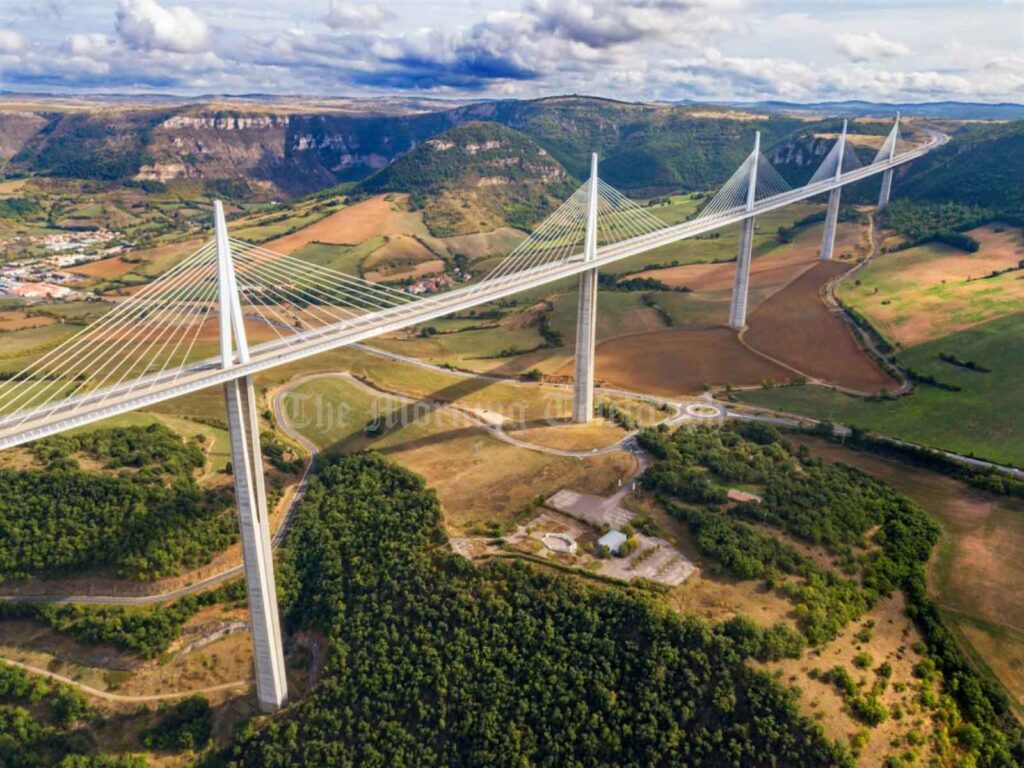
The Millau Viaduct, standing at 336.4 meters (1,104 feet) above the Tarn gorge in southern France, is not only the world’s tallest bridge but also a marvel of modern engineering and design. Spanning 2,460 meters (8,070 feet) across the valley, it represents a perfect fusion of artistic elegance and technological prowess.
Design and Engineering Prowess
Architectural Vision:
The Millau Viaduct’s design was led by renowned architect Norman Foster and engineer Michel Virlogeux. Foster’s vision was to create a bridge that would not only serve a functional purpose but also blend harmoniously with the natural landscape of the Gorges du Tarn. The result is a stunning cable-stayed bridge, characterized by its slender piers and gentle curves. The structure’s seven piers, each varying in height from 78 to 245 meters (256 to 804 feet), are paired with seven steel pylons rising 87 meters (285 feet) high. The bridge’s deck, 14 feet thick and weighing 36,000 tons, ensures a smooth and stable ride.
Engineering Challenges:
The design and construction process faced several challenges. The bridge’s high altitude required precise engineering to manage wind forces and temperature variations. The deck’s expansion and contraction – up to 50 centimeters (1.6 feet) – were managed through advanced extension joints. The assembly of the deck involved simultaneous launching from both sides of the valley, a process that required meticulous planning to ensure millimeter precision and prevent structural damage due to wind.
Geographic and Economic Impact

Google Earth, CNN
Transport Improvement:
The primary goal of the Millau Viaduct was to address the severe traffic congestion in Millau and the surrounding Massif Central region. Prior to the viaduct’s construction, travelers faced long delays due to bottlenecks in the area, impacting both local residents and long-distance travelers. The viaduct provides a seamless north-south connection between Clermont-Ferrand and Béziers, significantly reducing travel time and improving access to Spain. This has been a boon for regional economic development, facilitating trade and tourism.
Environmental Benefits:
The viaduct has also had a positive environmental impact. By alleviating traffic congestion, it has reduced air pollution and CO2 emissions. Estimates suggest that the bridge saves around 40,000 tons of CO2 emissions annually, equivalent to the carbon absorption of 40,000 trees over 40 years.

Nigel Young/Foster + Partners
Aesthetic and Environmental Considerations
Design Philosophy:
The Millau Viaduct was designed to complement rather than overshadow the natural beauty of the Gorges du Tarn. The bridge’s elegant design, with its slender and tapered piers, was intended to minimize visual impact while enhancing the landscape. The choice of a cable-stayed structure, with its minimal visual footprint, was driven by the desire to create a bridge that would harmonize with its surroundings.
Local Reaction:
Initially, the project faced opposition from local residents concerned about potential damage to the landscape and a decrease in tourism. However, once completed, the viaduct was embraced as a symbol of progress and innovation. It has since become a major tourist attraction, drawing visitors from around the world who come to admire its architectural beauty and engineering feat.
Construction and Project Management
Timeline and Costs:
Construction of the Millau Viaduct began in October 2001 and was completed in December 2004, with a total cost of 400 million euros ($437 million). The project was financed by Eiffage, a private construction company that still holds the concession for the bridge. Over 290,000 tons of steel and concrete were used in its construction, with around 600 builders working on-site.
Assembly Techniques:
The assembly of the bridge was a complex process involving launching the deck from both sides of the valley and meeting in the middle with millimeter precision. The construction team had to carefully monitor weather conditions to avoid damage during the assembly process. The successful completion of this phase demonstrated the precision and effectiveness of the design and construction methods employed.

Stephane De Sakutin/AFP, CNN
Cultural and Economic Legacy
Impact on Millau:
The Millau Viaduct has transformed the town of Millau from a traffic blackspot into a global landmark. The bridge has revitalized the local economy, attracting tourists and boosting local businesses. Visitors to Millau now have the opportunity to explore not only the viaduct but also the town’s historical and cultural attractions.

David Bagnall/Shutterstock
Ongoing Significance:
As the viaduct approaches its 20th anniversary, it remains a symbol of engineering excellence and a testament to the successful integration of design, technology, and environmental stewardship. The Millau Viaduct continues to be a significant asset to the region, enhancing connectivity, supporting economic growth, and drawing admiration from around the world.
In summary, the Millau Viaduct is not just a bridge; it is a transformative structure that has reshaped the landscape of southern France, boosted regional development, and become an iconic symbol of modern engineering and architectural achievement.




